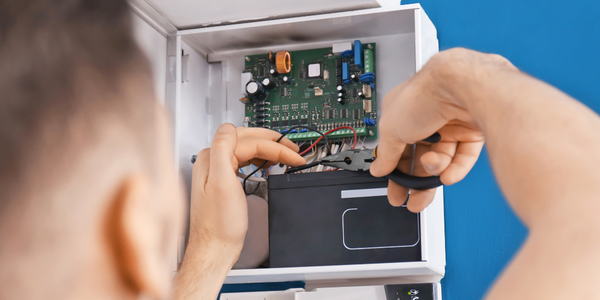下载PDF
Greater Peace of Mind with Pentair

技术
- 平台即服务 (PaaS) - 设备管理平台
适用功能
- 商业运营
用例
- 泄漏与洪水监测
挑战
当恶劣天气袭来时,对房屋的潜在损害可能是灾难性的。在美国,每年因水灾造成的损失保险索赔超过 30 亿美元,大多数房主甚至连地毯、石膏板、电器、家具和个人物品的基本水损都没有得到保障。污水泵是抵御洪水破坏的最佳防御措施之一,但当暴风雨停电时,传统的污水泵就变得无用了。作为水管理和设备保护的销售商,滨特尔寻求一个支持广泛的滨特尔互联网连接产品的通信平台。
客户
滨特尔有限公司
关于客户
Pentair Ltd. 是一家年收入 75 亿美元的公司,在全球范围内销售与水管理和设备保护相关的产品和服务。
解决方案
为了解决导致污水泵故障的停电问题,滨特尔选择了 Arrayent Connect 平台。依靠 Arrayent 的连接能力,滨特尔能够提供 Flotec FPDC30,这是一种连接的污水泵,可提供备用电池并包括滨特尔的 Link2O®。 Flotec FPD30 电池备用泵易于安装,可与任何现有的污水泵一起工作,并包括虚拟水助手,这是一项基于云的服务,可持续监控污水泵的活动。作为连接设备,当出现故障或房主关心的其他问题时,泵可以发送警报。当检测到问题时——备用泵在紧急情况下启动、家庭电力中断或电池电量低——Link2O 立即发送文本或电子邮件警报通知房主,从而限制潜在的洪水损坏。
收集的数据
Alarms For Automated Applications, Control System Alert, Equipment Status, Insurance Claims, Weather
运营影响
相关案例.

Case Study
Cisco Kinetic for Oil and Gas: Refineries and Plants
The plant manager and safety teams needed a solution that provided near real-time visibility of gas detection and personnel location, with easy to understand visualization and alerting dashboards. This would enable them to improve productivity through decreasing the time taken to start work, optimize evacuation route planning, and to meet critical staff safety and compliance goals.

Case Study
MICROMEDIA’S ALERT ASSISTS AIR LIQUIDE’S SCADA SYSTEM FABVIEW
WIN-911’s partner product ALERT is a key element in the Supervisory Control and Data Acquisition (SCADA) system “FabView” from Air Liquide. Air Liquide is the second largest supplier of industrial gasses in the world. This SCADA alarm notification system is specifically designed to monitor, among other things, the distribution of gas in a semiconductor manufacturing plant located in Dresden Germany. Like most operations of its type, this facility can’t afford much downtime in its distribution facility. If ALERT detects a leak in a pipeline, the system evaluates how severe the leak is and transfers the data back to the central site or home office. Once the information is back in the main office, the SCADA alert system then transcribes the data into understandable messages to which employees can respond appropriately.

Case Study
Eseye Pipe Leakage Detection
3.3 billion litres of water are lost through leaking pipes each day in the UK. As a result, water authorities face increasing demand to find innovative ways to monitor water flow within pipes. Currently, GSM data loggers are used to monitor water flow wirelessly and improve the efficiency of dealing with leaks. The big problem with GSM loggers is they use a network specific SIM, which means different SIMs are required for different locations due to network coverage.

Case Study
The city of Calgary using data to predict and mitigate floods
Every year, spring rains and snowmelt pour into the rivers and reservoirs that feed the City of Calgary’s water supply. As a result, downtown businesses and residents are faced with unpredictable floods that could do millions of dollars of damage. The City of Calgary turned to the PI System for a data-driven approach to predicting and managing flooding.Both the Bow and Elbow rivers flow through Calgary’s borders and provide fresh water to the system. These rivers carry the runoff, rainfall, and snowmelt from nearly 9,000 kilometers of land and the water is collected in two primary reservoirs managed by the City of Calgary. To ensure a safe, consistent, supply of water for its customers, the City of Calgary must keep a close eye on both the quality and quantity of water in these rivers and reservoirs. One of the biggest challenges in doing so is the region’s annual floods. Each year, between May and June, snowmelt, runoff, and rainstorms cause the water levels in the rivers to increase substantially. Preparing for flood-level waters is part of the utility’s annual plans, but predicting when, precisely, they would occur was another matter. Water tables can change quickly and the utility must balance flood risks against continuing to meet user demand and maintaining reservoir levels and water quality. During a flood event, the utility is faced with a surge in water volume through its system. Before water reaches the reservoirs, it must be treated and the sudden increase in volume caused by the floods often overwhelmed the treatment plants, resulting in quality issues. Furthermore, City of Calgary lacked timely information that would let it reduce reservoir volume in advance of a flood. As a result, emergency response often struggled to respond as flood waters reached downtown. The resulting damages — including residential and commercial insurance claims, water quality issues, system downtime, and regulatory fines — could total in the millions. To reduce the impact of floods on its customers and its business, City of Calgary, turned to the PI System.







